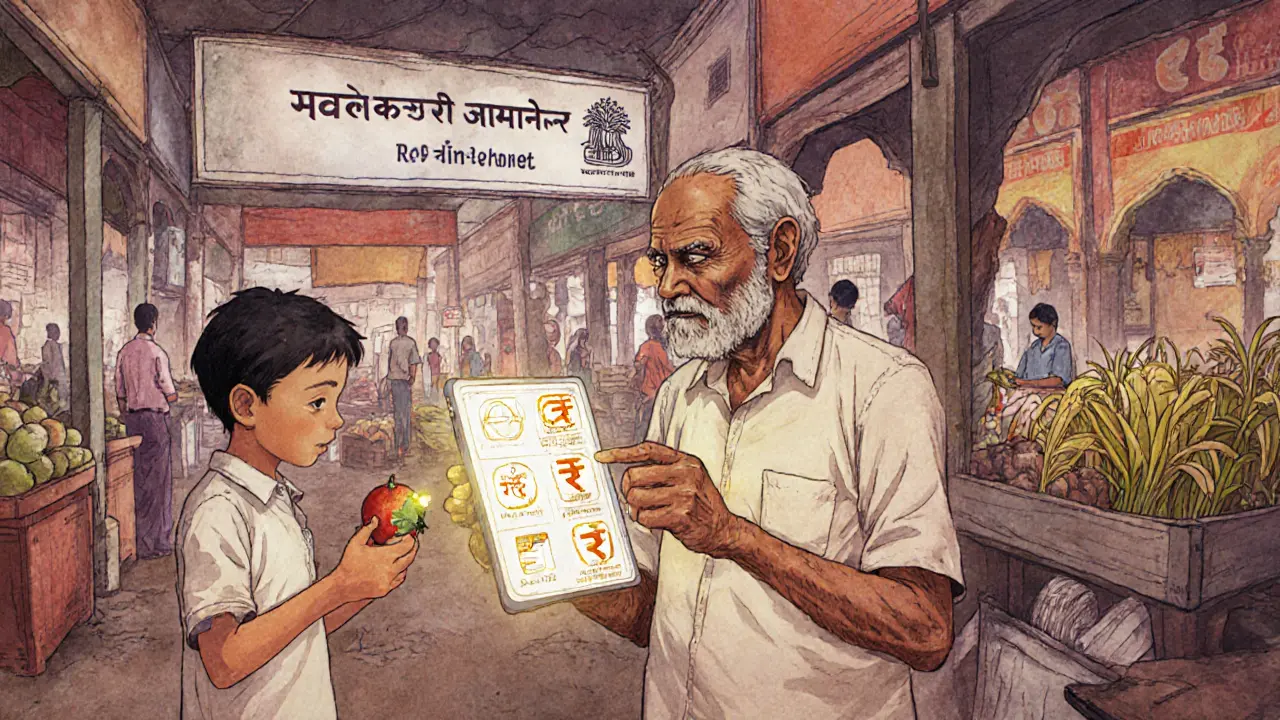By 2025, the world is no longer asking if digital money will replace cash-it’s asking who will control it. On one side, governments are rolling out Central Bank Digital Currencies (CBDCs) with military-grade precision. On the other, private cryptocurrencies like Bitcoin and Ethereum still hold sway over millions of users who distrust centralized systems. But this isn’t just a tech battle-it’s a power struggle over money, privacy, and national security.
CBDCs Are No Longer Experiments-They’re National Infrastructure
As of 2025, 134 countries, covering 98% of global GDP, are actively working on CBDCs. That’s up from just 114 in 2023. This isn’t a trend. It’s a global shift. Central banks aren’t tinkering with prototypes anymore-they’re building full-scale digital payment systems designed to replace cash and compete with private crypto. Countries like India have gone beyond pilots. The Reserve Bank of India now runs both retail and wholesale CBDCs, supports offline transactions, and lets small businesses and farmers use them without internet. Japan’s Bank of Japan has spent two years testing user interfaces, making sure elderly citizens and rural populations can use the system without needing a smartphone. These aren’t flashy crypto apps. They’re public utilities. And it’s not just about convenience. The real goal? Cut cross-border payment costs. In 2025, $59 billion in international transactions moved via CBDCs-up 45% from the year before. Projects like mBridge (led by China, Thailand, UAE, and Hong Kong) and Project Dunbar (Australia, Singapore, Malaysia, South Africa) are already settling trades between banks in real time, without intermediaries. Private crypto can’t match that scale or speed without sacrificing compliance.Why Private Crypto Is Losing Ground in Key Areas
Bitcoin and Ethereum were born to escape banks. They promised decentralization, censorship resistance, and freedom from government control. But in practice, most people don’t use them to buy coffee or send money abroad. They use them to speculate. And when markets crash, those same users scramble back to traditional banks. CBDCs don’t need to be perfect to win. They just need to be better at the things people actually care about: reliability, speed, and legal protection. If your CBDC transaction fails, you can call your central bank. If your Bitcoin wallet gets hacked? Good luck. Private crypto also struggles with regulation. In the U.S., the SEC still hasn’t decided if Ethereum is a security. In the EU, MiCA is forcing exchanges to comply with strict KYC rules. Meanwhile, CBDCs are built from day one with anti-money laundering (AML) and counter-terrorism financing (CTF) rules baked in. Forty-eight percent of CBDC projects already use blockchain-based identity systems to verify users faster than traditional banks can. And here’s the kicker: 26 central banks are actively building bridges between CBDCs and existing private payment apps like PayPal, Alipay, and Apple Pay. You won’t need a new wallet. You’ll just tap your phone like you always do. Private crypto still forces you to juggle wallets, seed phrases, and exchange accounts. It’s clunky. And users hate clunky.The Regulatory Advantage CBDCs Can’t Ignore
Private crypto thrives in gray zones. CBDCs thrive in clarity. That’s their secret weapon. Central banks have one thing no crypto project can replicate: legal authority. CBDCs are legal tender. They’re backed by the full faith and credit of the state. If you get paid in a CBDC, it’s as good as cash. No volatility. No counterparty risk. No “it’s just a token.” That’s why governments are pushing CBDCs for financial inclusion. In Nigeria, the eNaira helped unbanked farmers receive government subsidies directly. In Jamaica, the JAM-DEX let small businesses accept digital payments without credit card fees. In places where banks don’t reach, CBDCs do. Meanwhile, private crypto remains a luxury for the tech-savvy. You need a smartphone, internet, a crypto exchange account, and the confidence to hold volatile assets. Most people in developing economies don’t have those conditions. CBDCs don’t ask for permission-they just work.
The Real Threat: Bank Runs and Monetary Chaos
But CBDCs aren’t risk-free. The biggest danger isn’t hackers-it’s people. Imagine a sudden economic panic. People lose trust in their banks. They rush to convert their savings into CBDCs. That’s not science fiction. It’s exactly what the IMF warned about in October 2024. If millions of people pull their money out of commercial banks and into CBDCs overnight, banks can’t lend. Credit freezes. The economy stumbles. That’s why countries like Sweden and Canada are limiting how much CBDC an individual can hold. Others, like China, are designing CBDCs to pay zero interest-so people don’t treat them like savings accounts. The goal isn’t to replace bank deposits. It’s to replace cash. Private crypto doesn’t face this problem. Bitcoin doesn’t drain bank reserves. But it also doesn’t help stabilize the economy. It’s a parallel system-useful for some, dangerous for others.Security: CBDCs Are Built for Resilience, Not Anarchy
Crypto fans love to say blockchain is unhackable. It’s not. The Bitcoin network has never been broken-but exchanges have been robbed billions of dollars. Coinbase, Binance, FTX-all fell because of human error, not cryptography. CBDCs, by contrast, are built like Fort Knox. Over 100 central banks are investing in quantum-resistant encryption, hardware security modules, and real-time fraud detection. They’re not relying on decentralized nodes. They’re using centralized, audited systems with multiple layers of backup. The IMF found that while CBDCs create new attack surfaces, they also force governments to upgrade entire payment infrastructures. That means better firewalls, faster incident response, and mandatory cybersecurity standards for all financial service providers. Private crypto doesn’t have that. It’s a Wild West.
The Future: Coexistence, Not Conquest
This isn’t a zero-sum game. CBDCs won’t kill Bitcoin. But they’ll make it irrelevant for most everyday uses. Cross-border payments? CBDCs are winning. Financial inclusion? CBDCs are winning. Regulatory compliance? CBDCs are winning. Private crypto’s future lies in niches: censorship-resistant payments, decentralized finance (DeFi), and as a hedge against hyperinflation in failing states. Venezuela, Argentina, and Lebanon still see Bitcoin as a lifeline. But those are exceptions-not the rule. The real winner? People who get to choose. In New Zealand, you might use KiwiPay (a CBDC-backed app) to pay your rent, then hold a few Bitcoin as a long-term store of value. In Brazil, you might use the digital real to buy groceries, then trade crypto on weekends. That’s the future: layered systems, not one-size-fits-all.What’s Next? Don’t Wait for the Government to Decide
If you’re holding crypto, ask yourself: Are you using it for freedom-or just gambling? If you’re waiting for a CBDC in your country, check your central bank’s website. Most publish roadmaps. India’s digital rupee is live. Nigeria’s eNaira is expanding. China’s digital yuan is in 26 cities. You don’t need to pick a side. But you do need to understand the rules. CBDCs are coming. They’re not evil. They’re not utopian. They’re just the next step in how money works. And if you’re not ready, you’ll be the one stuck with outdated wallets and slow transfers.Are CBDCs the same as Bitcoin?
No. CBDCs are digital versions of your country’s official currency, issued and controlled by the central bank. Bitcoin is a decentralized cryptocurrency with no government backing. CBDCs are legal tender; Bitcoin is not. CBDCs can be traced and regulated; Bitcoin transactions are pseudonymous but not anonymous.
Can I use CBDCs to avoid government surveillance?
Not really. Most CBDCs are designed with transparency in mind. Central banks track transactions to prevent money laundering and tax evasion. Some pilot programs offer limited privacy for small, everyday purchases-but large transfers will always be visible. If anonymity is your goal, private crypto still offers more options, though even those are becoming harder to use without KYC.
Will CBDCs replace cash entirely?
Not anytime soon. Most countries are designing CBDCs to complement cash, not eliminate it. Sweden and Canada are moving fastest toward cashless societies, but even there, cash is still accepted. The goal is to reduce reliance on physical money-not remove it completely. People who rely on cash for privacy or accessibility will still have options.
Why are so many countries rushing to launch CBDCs now?
Three reasons: First, private crypto and stablecoins like USDT are already being used for cross-border payments, bypassing traditional banking. Second, China’s digital yuan is ahead, and other nations don’t want to fall behind in global finance. Third, CBDCs give governments better control over monetary policy, reduce fraud, and improve financial inclusion-especially in rural or unbanked areas.
Can private crypto survive alongside CBDCs?
Yes, but only in specific roles. CBDCs will dominate everyday payments, government transactions, and regulated finance. Private crypto will survive where decentralization matters most: censorship-resistant transfers, DeFi lending, and as a hedge against inflation in unstable economies. Think of it like email vs. postal mail-both exist, but for different needs.
What should I do if my country launches a CBDC?
Don’t panic. Wait for official guidance from your central bank. Download their app only from official sources. Don’t convert all your savings into CBDCs unless you understand the limits. Use it for daily spending if it’s faster or cheaper. Keep your crypto separate if you value its decentralized nature. The key is balance-not replacement.







Comments
Brian Gillespie
November 13, 2025 AT 03:35 AMCBDCs are just cash with a tracking chip. People don’t want surveillance, they want reliability. And right now, that’s what they’re getting.
Michael Faggard
November 14, 2025 AT 07:35 AMLet’s cut through the crypto evangelism. CBDCs aren’t about control-they’re about efficiency. Real-time settlement, programmable money, cross-border rails that don’t need SWIFT. The infrastructure is already built. Bitcoin’s still stuck on block confirmations and gas fees. It’s not a competition-it’s obsolescence.
Elizabeth Stavitzke
November 14, 2025 AT 16:02 PMOh wow, the great and powerful central banks are finally catching up to… what? The fact that people want to move money without middlemen? Please. You call that innovation? We’re just swapping one monopoly for another. At least Bitcoin doesn’t need your Social Security number to send $5.
Ainsley Ross
November 15, 2025 AT 00:24 AMAs someone who has worked in financial inclusion across Southeast Asia, I can tell you: CBDCs are transformative. In rural India, farmers are receiving subsidies directly via the digital rupee-no intermediaries, no delays, no corruption. This isn’t about control. It’s about dignity. Private crypto doesn’t reach these people. It doesn’t even try.
And yes, privacy concerns exist. But most CBDC pilots offer tiered privacy: small daily transactions are anonymous; large transfers are auditable. That’s not surveillance-it’s responsible governance.
Let’s stop framing this as freedom vs. control. It’s access vs. exclusion. And right now, CBDCs are winning that battle.
Arthur Crone
November 16, 2025 AT 17:26 PMCBDCs are the final step in the state’s total monetization of your life. You think you’re choosing convenience? You’re choosing compliance. Every transaction logged. Every purchase monitored. Every ‘suspicious’ flow flagged. Crypto might be messy-but at least it doesn’t report you to the IRS for buying coffee.
And don’t get me started on ‘financial inclusion.’ You don’t include people by forcing them into a system that watches them. You include them by giving them choice. CBDCs eliminate choice. That’s not progress. That’s control dressed in UI/UX.